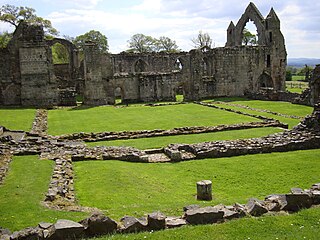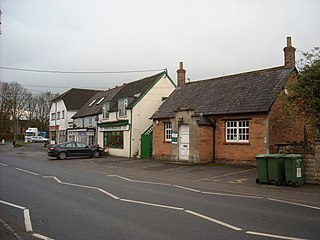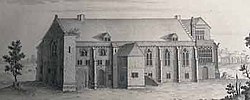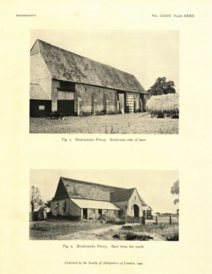
Cartmel Priory church serves as the parish church of Cartmel, Cumbria, England.

Lacock Abbey in the village of Lacock, Wiltshire, England, was founded in the early 13th century by Ela, Countess of Salisbury, as a nunnery of the Augustinian order. The abbey remained a nunnery until the Dissolution of the monasteries in the 16th century; it was then sold to Sir William Sharington who converted the convent into a residence where he and his family lived. It was fortified and remained loyal to the crown during the English Civil War, but surrendered to the Parliamentary forces once Devizes had fallen in 1645.

Gisborough Priory is a ruined Augustinian priory in Guisborough in the borough of Redcar and Cleveland, North Yorkshire, England. It was founded in 1119 as the Priory of St Mary by the Norman feudal magnate Robert de Brus, also an ancestor of the Scottish king, Robert the Bruce. It became one of the richest monastic foundations in England with grants from the crown and bequests from de Brus, other nobles and gentry and local people of more modest means. Much of the Romanesque Norman priory was destroyed in a fire in 1289. It was rebuilt in the Gothic style on a grander scale over the following century. Its remains are regarded as among the finest surviving examples of early Gothic architecture in England.

St Donat's Castle, St Donats, Wales, is a medieval castle in the Vale of Glamorgan, about 16 miles (26 km) to the west of Cardiff, and about 1+1⁄2 miles (2.4 km) to the west of Llantwit Major. Positioned on cliffs overlooking the Bristol Channel, the site has been occupied since the Iron Age, and was by tradition the home of the Celtic chieftain Caradog. The present castle's origins date from the 12th century when the de Haweys and later Peter de Stradling began its development. The Stradlings held the castle for four hundred years, until the death of Sir Thomas Stradling in a duel in 1738.

Haughmond Abbey is a ruined, medieval, Augustinian monastery a few miles from Shrewsbury, England. It was probably founded in the early 12th century and was closely associated with the FitzAlan family, who became Earls of Arundel, and some of their wealthier vassals and allies. It was a substantial, successful and wealthy house for most of its four centuries, although evidence of abuses appeared before its dissolution in 1539. The buildings fell into disrepair and the church was largely destroyed, although the remains of some of the domestic buildings remain impressive. The site is now in the care of English Heritage and is open to the public throughout the year and free entry.

Wiltshire is a historic county located in the South West England region. Wiltshire is landlocked and is in the east of the region.

Lyneham is a large village in north Wiltshire, England, within the civil parish of Lyneham and Bradenstoke, and situated 4 miles (6.4 km) southwest of Royal Wootton Bassett, 5.5 miles (8.9 km) north of Calne and 11 miles (18 km) southwest of Swindon. The village is on the A3102 road between Calne and Wootton Bassett.

The Church of the Holy Ghost, Midsomer Norton, Somerset, England is a Roman Catholic parish church housed in a converted tithe barn. It is served by monks of the Order of St. Benedict from Downside Abbey and is a Grade II* listed building.

St. Botolph's Priory was a medieval house of Augustinian canons in Colchester, Essex, founded c. 1093. The priory had the distinction of being the first and leading Augustinian convent in England until its dissolution in 1536.

Norton Priory is a historic site in Norton, Runcorn, Cheshire, England, comprising the remains of an abbey complex dating from the 12th to 16th centuries, and an 18th-century country house; it is now a museum. The remains are a scheduled ancient monument and are recorded in the National Heritage List for England as a designated Grade I listed building. They are considered to be the most important monastic remains in Cheshire.

Horningsham is a small village and civil parish in Wiltshire, England, on the county border with Somerset. The village lies about 4 miles (6 km) southwest of the town of Warminster and 4+1⁄2 miles (7 km) southeast of Frome, Somerset.

The remains of St Mary's Abbey, of Kenilworth, Warwickshire, England are situated in the grounds of St Nicholas' Church and in an adjacent area of Abbey Fields. Some of its ruins are above ground and some are below ground.

Bradenstoke is a village in Wiltshire, England, lying to the north of the former RAF Lyneham airbase and 1.5 miles (2.4 km) northwest of Lyneham. Originally lying within Braydon Forest, the "stoke" means "settlement".

Hatfield Broad Oak Priory, or Hatfield Regis Priory, is a former Benedictine priory in Hatfield Broad Oak, Essex, England. Founded by 1139, it was dissolved in 1536 as part of Henry VIII's dissolution of the monasteries.
Edward of Salisbury was a nobleman and courtier (curialis), probably part Anglo-Saxon, who served as High Sheriff of Wiltshire during the reigns of William I, William II and Henry I.

Leonard Stanley Priory was a priory in Gloucestershire, England. Over the years following the dissolution most of the buildings of the priory complex have been destroyed.

Wilcot is a village and former civil parish, now in the parish of Wilcot, Huish and Oare, in Wiltshire, England, in the Vale of Pewsey about 6 miles (10 km) southwest of Marlborough and 1.5 mi (2.4 km) northwest of Pewsey. In 2011 the parish had a population of 558.

There are over 670 scheduled monuments in the ceremonial county of Somerset in South West England. The county consists of a non-metropolitan county, administered by Somerset County Council, which is divided into five districts, and two unitary authorities. The districts of Somerset are West Somerset, South Somerset, Taunton Deane, Mendip and Sedgemoor. The two administratively independent unitary authorities, which were established on 1 April 1996 following the breakup of the county of Avon, are North Somerset and Bath and North East Somerset. These unitary authorities include areas that were once part of Somerset before the creation of Avon in 1974.
William Snow was the inaugural Dean of Bristol.


























